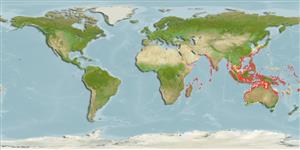>
Gobiiformes (Gobies) >
Gobiidae (Gobies) > Gobionellinae
Etymology: Oxyurichthys: Greek, oxys = sharpen + Greek, oura = tail + Greek, ichthys = fish (Ref. 45335).
More on author: Valenciennes.
Environment: milieu / climate zone / depth range / distribution range
Ecologia
marino; salmastro associati a barriera corallina; distribuzione batimetrica 1 - 50 m (Ref. 37816). Tropical
Indo-West Pacific: Red Sea south to Natal, South Africa and east to the tropical west Pacific.
Size / Peso / Age
Maturity: Lm ? range ? - ? cm
Max length : 22.0 cm TL maschio/sesso non determinato; (Ref. 127374); peso massimo pubblicato: 52.00 g (Ref. 127374)
Short description
Chiavi di identificazione | Morfologia | Morfometria
Spine dorsali (totale) : 7; Raggi dorsali molli (totale) : 12; Spine anali: 1; Raggi anali molli: 13. Body brown with 7-8 vertical dark brown bars (Ref. 2798); characterized further by pale brownish grey body color with orange spots/bands on cheek and operculum; united pelvic fins, well developed frenum present; long and pointed caudal fin, nearly twice length of head; longitudinal scale series 75-80; ctenoid scales posteriorly to below middle of first dorsal fin, becoming cycloid anteriorly; scales absent on head, midline of nape and prepectoral area; low fleshy ridge on midline of nape; depth of body 5.6-6.5 in SL (Ref. 90102).
Occurs inshore (Ref. 4343), mud bottoms of estuaries and protected bays (Ref. 37816). Found on open flat bottom and large adults mostly seen at about 30 meters depth. Dives head first into the mud for safety (Ref. 48637). Hides in a burrow, but can dive into mud to escape predators (Ref. 11441).
Life cycle and mating behavior
Maturities | Riproduzione | Spawnings | Egg(s) | Fecundities | Larve
Maugé, L.A., 1986. Gobiidae. p. 358-388. In J. Daget, J.-P. Gosse and D.F.E. Thys van den Audenaerde (eds.) Check-list of the freshwater fishes of Africa (CLOFFA). ISNB, Brussels; MRAC, Tervuren; and ORSTOM, Paris. Vol. 2. (Ref. 4343)
IUCN Red List Status (Ref. 130435)
Threat to humans
Harmless
Human uses
Pesca: commerciale; Acquario: Commerciale
Strumenti
Special reports
Download XML
Fonti Internet
Estimates based on models
Preferred temperature (Ref.
123201): 24.6 - 29, mean 27.9 °C (based on 950 cells).
Phylogenetic diversity index (Ref.
82804): PD
50 = 0.5000 [Uniqueness, from 0.5 = low to 2.0 = high].
Bayesian length-weight: a=0.00912 (0.00568 - 0.01465), b=2.94 (2.81 - 3.07), in cm total length, based on LWR estimates for this species & (Sub)family-body (Ref.
93245).
Trophic level (Ref.
69278): 3.5 ±0.37 se; based on food items.
Resilienza (Ref.
120179): Medio, tempo minimo di raddoppiamento della popolazione 1.4 - 4.4 anni (Preliminary K or Fecundity.).
Fishing Vulnerability (Ref.
59153): Low vulnerability (12 of 100).
Nutrients (Ref.
124155): Calcium = 64.2 [34.4, 121.6] mg/100g; Iron = 0.604 [0.305, 1.060] mg/100g; Protein = 18.9 [16.9, 20.5] %; Omega3 = 0.157 [0.075, 0.262] g/100g; Selenium = 24.4 [13.2, 50.3] μg/100g; VitaminA = 112 [31, 365] μg/100g; Zinc = 1.68 [1.18, 2.39] mg/100g (wet weight);
